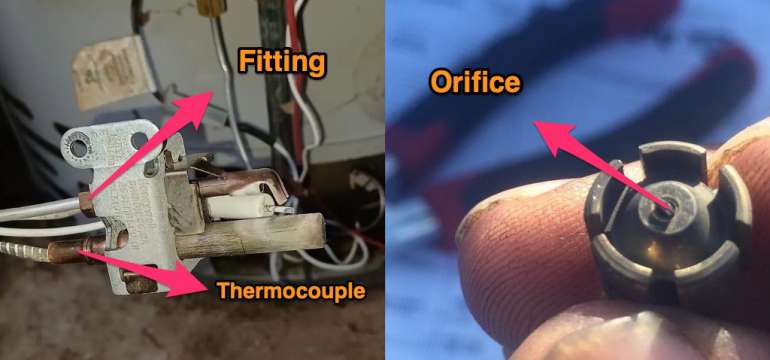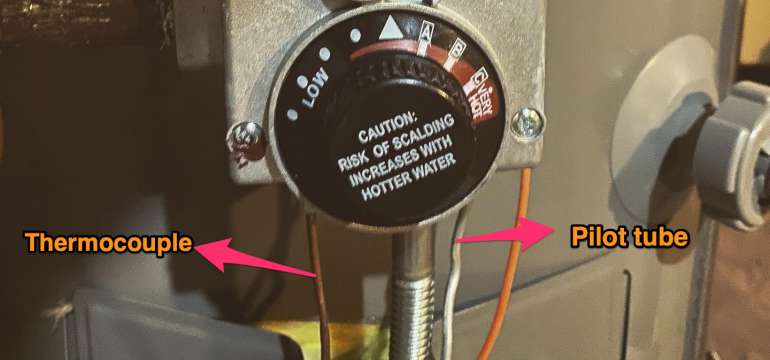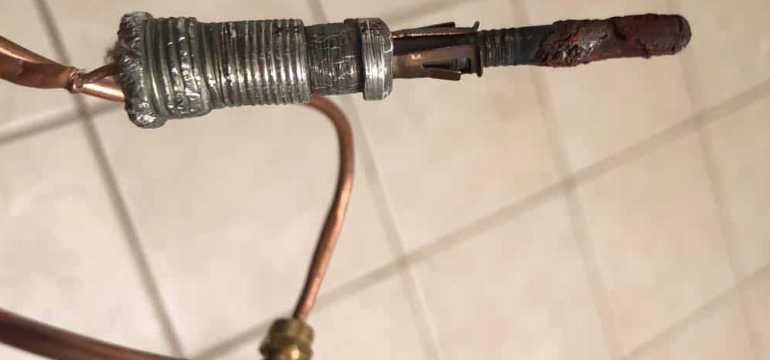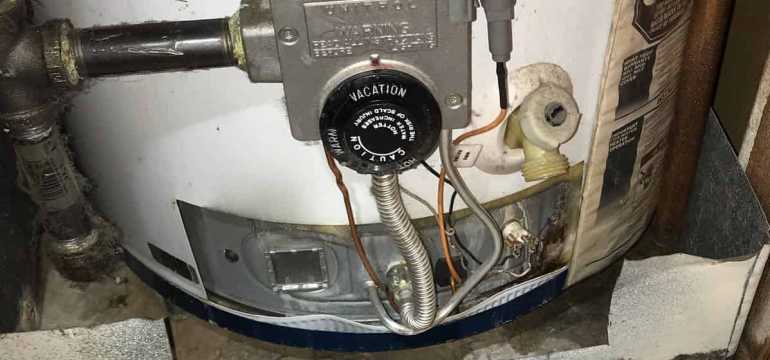There are several reasons why your hot water heater pilot light may keep going out. It can be as simple as a wind gust in your home. Or it might be an issue with a part, such as a worn-down thermocouple. The problem could even be a sign of a more serious issue with your hot water heater.
This article will help you both discover the source of your problem and the solution to it. Keep reading to find out why your hot water heater pilot light keeps going out and what to do about it.
1. Start by cleaning your supply tube and pilot orifice

Your water heater’s pilot orifice is a part that controls the flow of gas that the unit receives. Even a tiny amount of interference in the flow of gas could interfere with your pilot light.
To check for this, the first step is shutting off the gas line to the water heater. You should have a valve that controls this.
After that, find the pilot orifice. It should be near the end of the pilot supply line, and it will look like a little brass cup. Take off the fitting by twisting it to the left, then unscrew the orifice from it.
You can then hold the part up to a light and look through it. You might want to tap on it as well to see if it’s clogged. You can even blow through the pilot supply tube and then use a dampened cotton swab with rubbing alcohol to clean it.
After you’ve done that, you can reassemble and reattach the fitting and try the pilot light again. It may be all that you need to fix your issue.
2. Check on your thermocouple

The next thing that you can check is your thermocouple. This part is responsible for detecting when the pilot light is burning. It has a copper rod that serves as a safety feature to shut off the gas supply when the pilot light goes out.
Over time, a thermocouple can get bent out of position. It could also get damaged or coated in dirt and built-up carbon. When that happens, the thermocouple could make inaccurate readings and cause the heater to shut down when it doesn’t actually need to.
Here’s what to do about it
- Start by turning off the gas that feeds your water heater. The location for this will be different on every unit, so read your manual if you’re not sure.
- Next, use a wrench to remove the thermocouple line. After that, take off the gas line and also the line that the pilot light uses. Your thermocouple will usually be a left-hand thread, whereas the main gas line could be a right-hand thread. Your pilot light tube will also typically be a right-hand thread but will vary based on the water heater model you have. One thing to note is that some systems have a protective cover over their burner compartments. If yours does as well, then you’ll likely need to remove the cover to be able to work on the unit.
- Next, you can remove the thermocouple from the burner itself. You typically won’t need any tools to do this. But the thermocouple may be connected to the pilot tube with clips. If so, you may need to remove those clips in order to remove the thermocouple.
- If you discover a dirty thermocouple, then you can use sandpaper to scrub off any grime. If the thermocouple is kinked, then you may need to manually straighten it back into the standard position.
- Once you’ve taken care of this, you can reassemble the burner and thermocouple, doing the opposite of what you just did. Make sure that you don’t cross any threads and that you secure all three of the fittings as tightly as you can.
- Finally, you can finish the process by turning on the gas and relighting the pilot light. Hopefully, this will have fixed your problem.
3. Replace your thermocouple, if necessary

If the steps covered in the previous section didn’t work for you, then you may need to replace your thermocouple. The good news is that replacement thermocouples are often fairly inexpensive, and you’ll likely be able to pick one up for around $25.
That being said, there are multiple sizes of thermocouples to choose from, and you want to make sure you get the same one you have currently. So it’s a good idea to take your old one with you to the hardware store to ensure you get a good match.
4. Take a look at your flex tube
 The flex tube is an important part of your hot water heater and is attached to the gas controller. The main goal of the flex tube is to ensure the gas in your water heater tank is flowing properly. They can sometimes get kinks and twists that can impact the pilot light.
The flex tube is an important part of your hot water heater and is attached to the gas controller. The main goal of the flex tube is to ensure the gas in your water heater tank is flowing properly. They can sometimes get kinks and twists that can impact the pilot light.
These don’t have problems as often as thermocouples do. But the solution is pretty straightforward. Simply straighten out any kinks that you find on the tube. You may also want to keep an eye out for visible damage, as it could be a potential sign of a gas leak.
5. Think about your water heater’s location and chimney caps
It’s also possible that air is causing your pilot light problems. For example, your pilot light may not receive enough air to maintain its flame if it’s in the basement. Or it could be getting too much air if it’s in a drafty hallway.
One thing to note is that if your water heater is in a confined space that has stagnant airflow, the flame may be starved of oxygen. This could create a situation in which dangerous levels of carbon monoxide are allowed to build up in the room. You can improve ventilation by opening the area around the water heater or by using a small fan.
You may also need to install a chimney cap if you live in an area with frequent high gusts of winds (exceeding 40 miles per hour). There are even wind-directional chimney caps out there, which help create stronger updrafts and better ventilation while also forcing the wind away from your home.
Other reasons why your water heater pilot light can go out
The reasons we’ve already covered are the most common causes for a pilot light that keeps going out. But here are some other potential issues that are worth examining as well.
Gas turned off or low inlet pressure
You can take a look at your manual gas valve handle to ensure that it’s in the same direction as the gas stream. It should be in the on or open position. You can also look at the pilot knob to make sure that it’s in the proper position, which you can confirm by pressing the knob all the way down. You may even have an empty propane tank that’s causing your problem.
The main control valve is malfunctioning
The main control valve is another portion of your hot water heater that can cause your hot water heater pilot light to keep going out. Although the main control valve seldom breaks down, it can happen.
When the main control valve does require repair, you’ll need to call a professional to replace it.
Sparker is no longer producing a spark
It’s also possible that your sparker is no longer working properly. There must be a full electrical circuit in order for it to function. So it’s possible that the sparker is too far away from the gas valve. Or, it may have just broken from normal wear and tear.
The pilot flame is too small, has low pressure
Another potential reason for this problem is a flame that’s too small. When the flame doesn’t envelope the rod, the thermocouple won’t be able to generate the correct amount of voltage that it needs to hold the solenoid in an open position. This can also cause the pilot light problems that you’re experiencing.
The pilot flame termination head is bent
Another possibility is that the pilot flame termination head is bent. If yours is broken or just bent, don’t try to repair it. You generally won’t be able to do so successfully anyway, so it’s better to just replace it with a new one.
You have a busted water heater thermal limit
Some brands of water heaters use thermal limit safety sensors. These are designed to protect the combustion chamber from overheating. If one of these were to break or have a loose wire, it could interfere with your pilot light in various ways.
Your water heater solenoid is no longer working properly
Finally, you may also be having an issue with your water heater solenoid. This is located inside the gas valve and the thermocouple. If you’ve tried everything else and none of the fixes have worked, then it’s likely that you’ve got a problem with your solenoid.
- If You Have No Hot Water Pressure, Here’s What You Should Do - December 28, 2021
- What is the Right Shower Drain Pipe Size? - January 25, 2020
- Wet Vent Plumbing, What Is It? How Do You Utilize It? - November 17, 2019


Ron DiBattista
Wednesday 8th of February 2023
My three year old gas water heater pilot went off for the first time. I relit it easily. What’s your hunch on why the pilot would’ve gone off. It’s in the basement with no draft.